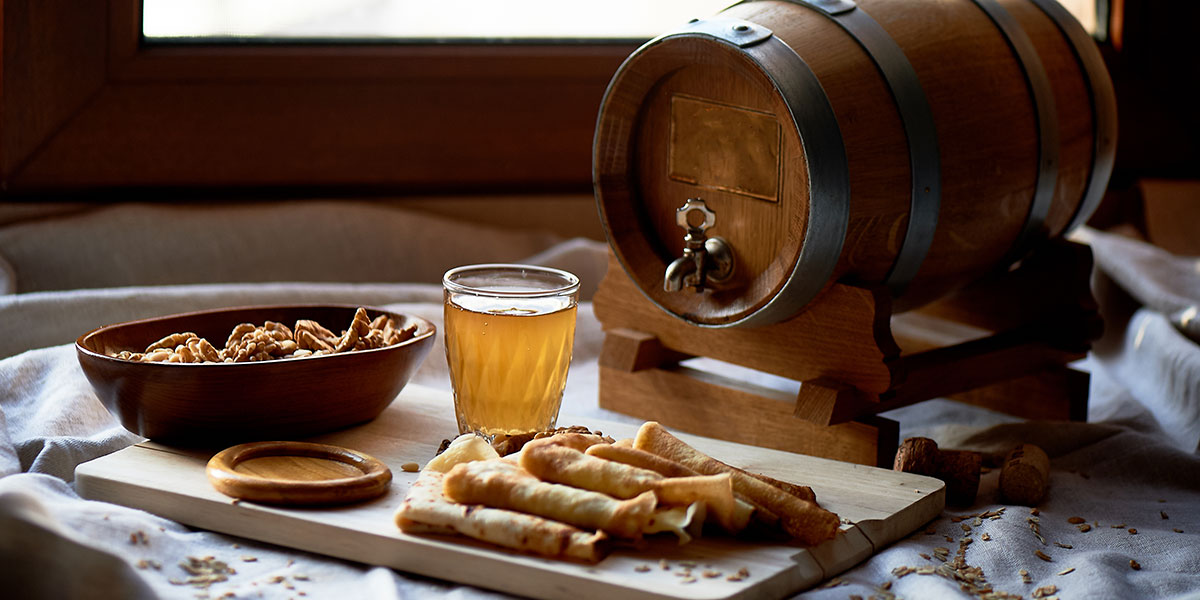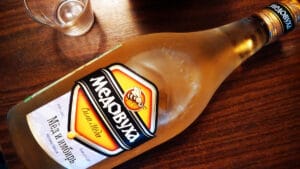Medovukha (медовуха) is a Slavic honey-based alcoholic beverage. It is one of the most recent and perhaps the best known iteration of a long evolutionary tree of Russian honey-based beverages that can be traced all the way back to the Old Slavs.
In Russia today, some argue that a return to these honey drinks, which are traditionally non-alcoholic or lightly alcoholic (similar to beer), should be seen as not only part of a wider cultural revival, but also a return to a healthier lifestyle that existed before the advent of vodka.
Medovukha is also considered traditional in many diverse Slavic cultures and can be found today in supermarkets and bars in Russia, Belarus, Ukraine, and Poland.
Why It’s Called “Medovukha”
(Почему носит такое название?)
The word “medovukha” is a noun made from the adjective “medovyi” (медовый) which itself comes from the simpler noun “myod” (мёд), or “honey.” Thus, the name simply indicates that the drink is derived from honey. Interestingly, the Russian word “myod” (мёд) is directly related to the English “mead” through the common Proto-Indo-European ancestor of “meddhe,” meaning “honey.” The drink was shared throughout much of the ancient word, from the Caucuses to Scandinavia and from Greece to Ireland.
In Old Russian texts, dating back to the 9th century, “med” (мeд) is often the name used for both the fermented drink and its main ingredient. These early drinks were also often referred to as stavlennyi myod (ставленный мёд) or myodostav (мёдостав) for short. Both mean “set honey” or “aged honey.”
The term “medovukha” only appeared in the 18th century, originating in Veliky Novgorod, and gained wide acceptance only in the 20th. Although the differences between medovukha and its predecessors are mostly technical, there are some in Russia that argue that to get to a true Slavic drink, one must look further back in history to earlier forms.
How to Brew Medovukha
(Как правильно приготовить медовуху?)
Honey has natural antibiotic properties. Thus, getting it to ferment is not a quick or easy process. Early recipes for “aged honey” called for two parts honey, and one part berry juice. Other additives could include herbs, pollen, and/or nectar, which affected the taste and what were believed to be the mystical properties of the drink. The berries added moisture and wild bacteria and yeasts which allowed fermentation to start. Barrels filled with the mixture were then sealed with resin and buried for fifteen to twenty years, generally resulting in an alcohol content of about 6-16%. Given the difficult production of the beverage, it was a very high value drink.
Adjustments to the recipe and process were made mostly to try to speed up fermentation. Already in the 10th century, hops were sometimes added to mixture, which would produce a stronger honey drink faster, allowing it to be consumed in 5-10 years. During the 11th century, heat was used approximately halve the fermentation process again. Further, in the 14th century, the distillation tank was invented, allowing an even faster and more consistent product to be produced. Modern medovukha is a culmination of all these advances, often using hops along with specially grown yeast, controlled heat and moisture, and specialized, modern production facilities to produce a fermented drink in about a week.
The recipe for modern medovukha may be as simple as two ingredients; honey and yeast or another catalyst. Berries, herbs, spices, and even pollen and nectar are still sometimes used to create a more robust flavor platform. After fermentation occurs, the beverage should age for at least a few days, but is often left for six months in a cool place to achieve full flavor.
The main difference between medovukha and its early predecessors is that it is brewed under highly controlled conditions, with yeast specially prepared for the purpose, and the brewers could thus carefully control the drink’s sugar and alcohol concentrations.
How to Drink Medovukha
(Как правильно пить медовуху?)
Medovukha usually maintains an alcohol percentage of 2-8.5% which makes it a sipping drink that usually consumed like wine. It pairs nicely with meals, especially chicken and pork, and many connoisseurs suggest using charcuterie boards with medovukha to pair it with fruits, breads, nuts, cheeses, and meats.
Fermented honey drinks were once used primarily for festivals, rituals, and weddings. At the beginning of a feast, an offering of medovukha was often made to the gods. In many places both within Russia and without, honey and honey beverages were heavily associated with health, vitality, and fertility. Some regions even believed “nutritious honey” had magical powers of resurrection. The beverage was also given at weddings with often a month’s store of honey or honey drink for the bride and groom to keep them healthy and help them conceive. This tradition, which became common in many cultures, led to the term “honeymoon;” in Russian, it is simply “honey month” (медовый месяц; medovyi mesyats). Fermented honey was also often drunk at funerals as a way to affirm life while mourning the dead.
Some medovukha advocates also claim that it is good to drink to cure or prevent colds.
What Happened to Medovukha?
(Почему перестали пить медовуху?)
Drinking medovukha today has a purposeful feeling. One feels like one is connecting with the culture and history of a time when medovukha was an essential ritual drink.
In its past, as medovukha was able to be produced more quickly and cheaply, it grew in popularity, and was available to a broader audience. However, medovukha fell out favor at least in part due to government policy.
In the 16th century, Prince Vasily III of Moscow prohibited private production of medovukha, and declared that it could only be produced by the church and state. It then became a revenue source for these two institutions. During the 18th century, Peter the Great found that vodka could be quickly fermented to very high alcohol levels using much cheaper ingredients. He nationalized vodka production as well as encouraged its production over medovukha because it could be taxed at higher rates. Medovukha, which had been considered Russia’s national brew before that, was largely wiped out by the end of Peter’s reign.
In the early years of the USSR, there was a brief revival of medovukha as the Soviets encouraged moving back to historically significant cultural traditions and found that they had a surplus of honey in those early years. However, medavukha was soon overtaken by vodka again as an important source of tax revenue and as honey production was deprioritized.
Since the 1990s, there has been a growing culinary trend in Russia to return to local ingredients and older traditions. Honey production has also increased, allowing some regions, such as Suzdal, to become particularly known for medovukha production. Today, a small selection can be found in some supermarkets across Russia, often brought from Suzdal.
Perhaps the greatest boon in Russia for medovukha, however, has come from the home brewing and craft craze that has swept Russia since about 2014. Today, many enthusiasts are experimenting in small batches with ways to truly bring Russia’s traditions of fermented honey back to life. Their products can be found in specialty beer shops and craft brew pubs, where the drink can often be found bottled or on tap.
Preparing Medovukha
(Давай приготовим!)
The recipe below features a version of Medovukha without yeast.
Ingredients:
Preparation: Combine honey with water, stir and heat over minimal heat. Put the hop cones in a bag and place it in the syrup. Keep the composition on a minimum heat for an hour, compensate for the liquid that evaporates with boiled water. Pour the warm mass into a different container, wooden or glass, which should be 20% larger in volume than the liquid. Place the vessel in a warm place and install a water seal to release gases. When fermentation is over, add the glass-brewed tea. Pour the mead into glass bottles and leave in the basement for six months. |
Ингредиенты:
Приготовление: Мед с водой соедините, размешайте и нагрейте на минимальном огне. Шишки хмеля положите в мешочек и опустите в сироп. Состав держите на минимальном огне час, жидкость, которая испаряется, компенсируйте кипяченой водой. Теплую массу перелейте в другую деревянную или стеклянную емкость, при этом она должна быть больше по объему на 20%. Сосуд поставьте в теплое место и установите гидрозатвор для выделения газов. Когда ферментация закончится, добавьте заваренный в стакане чай. Медовуху разлейте в стеклянные бутылки и оставьте на полгода в подвале. |
The recipe below features a version utilizing berries and yeast.
Ingredients:
Preparation: Rinse the berries and mash them through a meat grinder. Simmer the water and honey for 5 minutes over the fire, removing the foam. Put the berries in and cook for 5 minutes, then let the syrup cool. Dissolve the yeast in warm water and pour into the rest of the mixture. Leave the syrup to ferment for two days. Filter the drink and pour it into plastic bottles, leave it in a cool place for 3 weeks. During this time, watch the containers and, if any of the bottles swell, open the lid to release the accumulated gases. |
Ингредиенты:
Приготовление: Ягоды промойте и перекрутите через мясорубку. В емкость налейте воды, добавьте мед и томите 5 минут на огне, снимая пену. Плоды положите в емкость и варите 5 минут, затем дайте сиропу остыть. Дрожжи разведите в теплой воде и влейте в общую массу. Сироп оставьте бродить двое суток. Напиток профильтруйте и разлейте в пластиковые бутылки, отправьте в прохладное помещение на 3 недели. В это время следите за тарой, если бутылки вздулись, то откройте крышку, чтобы вышли скопившиеся газы. |
Our Favorite Medovukha Videos
Below is a short video of a man preparing apple medovukha. He speaks at a pretty clear rate, and shows step-by-step exactly what he is doing, and the exact measurements he uses. He displays a nice fruity recipe for the traditional beverage using yeast.
Below is another video for medovukha. This man speaks at a slower rate, and uses a recipe without yeast! He shows step-by-step what to do, at a slow pace.
This last video gives much detail about the beverage, how to choose the honey, and more. The host also speaks quite slowly and clearly.












